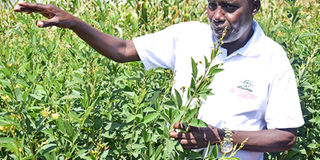Here’re fast-maturing legume crops

Egerton University plant breeder Dr Bernard Towett demonstrate the new varieties of pigeon pea which have huge potential for export market.PHOTO|ELIZABETH OJINA
What you need to know:
- The drought-resistant crop grows in various agro-ecological zones such as dry highlands, medium altitudes and also in dry lowlands with annual rainfall range of 250-550mm per annum.
- Chelalang variety grows best in areas with higher rainfall, according to him, while Tasha in medium and high altitude areas while Ciangui in low lands
Opoda Farm in Bondo, Siaya County, last week registered one of its biggest traffic ever as farmers trooped the establishment for agro-lessons and interaction with experts.
Some 500 of them turned up at the facility and among the lessons they went back home with are on new drought-tolerant, disease-resistant and fast-maturing legume and cereal crops, amaranth, pasture and sweet potatoes.
Dr Bernard Towett, a plant breeder from Egerton University, had an array of legume crops that he discussed with farmers, among them chickpea, which he noted has a huge potential for the export market.
The drought-resistant crop grows in various agro-ecological zones such as dry highlands, medium altitudes and also in dry lowlands with annual rainfall range of 250-550mm per annum. The crop thrives best in the black cotton soils.
Dr Towett noted that in Siaya County, the legume does well in Uyoma, Rarieda and Asembo, which receive little rainfall.
It also grows well in Kisumu, Migori, parts of Bomet, Mbeere, Matuu in Kitui County, Baringo, Karaba in Mwea and Taita Taveta.
Farmers can grow two varieties namely Kabuki, which is large, whitish cream and shaped like a head of an owl and Desi, which is small, pea-shaped and dark brown in colour. “Kabuki is liked by the local market for its light colour while the Desi is best for export market,” said the plant breeder.
Plant legume off season
For the best results, the expert advised farmers to plant the legume off season, that is immediately one has harvested any cereal crop. "It is a rotational crop, so you plant it after the harvest of maize for example," said Dr Towett, noting its enemies include fungal disease such Ascochyta blight, which affects leaves.
The disease develops rapidly in cool wet conditions with high humidity. Hot, dry conditions can halt the development of the disease but can later spread with wet conditions, said Dr Towett.
A single chickpea plant has 300 pods, with each carrying two seeds.
It has a yield potential of 10-12 bags per acre. In supermarkets, a kilo goes from Sh350 to Sh400 respectively.
"Because of its potential in the export market, we are contracting farmers to be seed producers under the supervision of Kenya Plant Health Inspectorate Service (Kephis) inspectors. Once the produce is ready for harvest, we buy back at Sh100 per kilo," he told farmers.
To be a contract farmer, one should have at least 10 acres or those with small parcels can alternatively farm in clusters of between two to three acres for easier inspection," he explained.
High quality seeds
Kephis Nyanza regional manager Geoffrey Malemba said that they partner with seed companies to ensure only quality seeds are produced.
“First we train both the seed companies and farmers (seed producers) on achieving quality seeds before they are sold in agrovets. We take them through the inspection process, to make sure they produce quality seeds.”
Mr Malemba went on: “We also inspect seeds that farmers will be given by the merchants or seed company if they are certified.”
He said the biggest threat to farmers who are producing cereal crops (maize, sorghum, millet) and legumes is the striga weed, but there are seed varieties resistant to the weed in the market.
Chelalang, Tasha and Ciangui beans were the other legumes showcased at the event. The beans are free of acidity and gases, according to Dr Towett.
Chelalang variety grows best in areas with higher rainfall, according to him, while Tasha in medium and high altitude areas while Ciangui in low lands. The crops mature in three months and have a yield potential of 8-12 bags per acre.
In yester years, Siaya and other parts of Nyanza were known for robust production of groundnuts. However, with lack of quality seeds and poor management, production has gone down over the years.
However, farmers can now plant superior variety of white and red groundnuts named EUGN 1. They are big in size and have high oil content.
Finger millet
The plant breeder said the variety offers eight to 12 bags of groundnuts per acre as compared to local varieties, which yield four.
Farmers, however, have to look out for leaf spot and groundnut rosette disease.
Another crop which offers farmers in the lowlands bright prospects include finger millet and pigeon peas.
Finger millet developed by Egerton University matures in 75 days and offers eight to 10 bags per acre.
Traditionally, pigeon peas (mbaazi)has been mainly grown in Eastern but according to Dr Towett, the crop has the potential to do well in western Kenya lowlands.
He warned farmers that if they fail to spray the crop against pest and diseases, they are like to get nil harvest.




